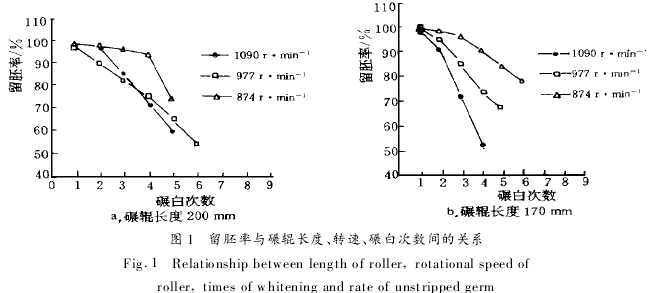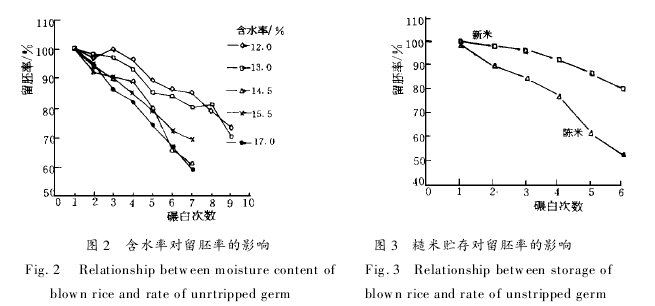According to nutritionist research, rice germ contains a variety of trace elements and vitamins and unsaturated fatty acids that are beneficial to the human body, which can be described as the essence of rice. The prevalence of vitamin B1 deficiency, such as beriberi and oral ulcers, is mainly caused by long-term staple foods that grind fine white rice from germs. Vitamin B1 is mainly found in cereal germs. During normal rice milling, the embryos are removed as the whitening action progresses. This is a great waste of good nutrition vitamin B1, resulting in the lack of vitamin B1, and then induce more serious diseases [1,2]. Therefore, how to make full use of rice germ and increase the rate of retained embryos in polished rice is a meaningful task. Studies have shown that the damage of the germinating process is extremely small. The key to improving the embryo retention rate of polished rice is to increase the rate of retained embryos in the milling process.
Japan stipulates that polished rice with an embryo rate of more than 80% can be called germ rice [3]. Germ extract rice is made from special rice milling equipment and is ground by a special whitening process [4]. In this study, a large number of experimental studies were conducted on the process of processing germ rice, and the structural parameters such as roller rotation speed, grinding gap, and roller structure were analyzed, and the influence of technological parameters such as number of times of milling, outlet pressure, and brown rice moisture content on the rate of retained embryos was analyzed. , got the optimized combination of parameters. The germ rice produced by the developed vertical germ rice mill can reach the whitening accuracy of ordinary rice, good palatability, and rich in many nutrients such as vitamins, choline and inositol [5]. It is much larger than normal polished rice, so germ rice is a natural and nutritious health food that is worth developing.
1 Test materials and indicators
1.1 Test equipment Ket correct moisture meter for drying, vertical germ rice machine (homemade), oven, miller combination rice mill, PMEI - particle meter.
1.2 Test materials The rice used in this test was Su-22 stalk rice, and the brown rice was obtained by re-sorting the waxy grains on a rolling mill.
1.3 Test indicators
1) Percentage of embryos remaining: the ratio of the number of embryos left and the number of types of rice.
2) Grinding precision: It refers to the degree of lingering of an agglomerate, which is detected by the Zhenjiang City Grain Bureau Central Laboratory.
2 tests and analysis
2.1 The effect of the roller speed In order to get different speeds of rice mill, using different diameter pulley combination, a total of nine kinds of speed test. Tests have shown that when the speed is 745, 874, 977, and 1090 r/min, the rice milling effect is good, and the rest of the speed is no longer used in other test items.
Table 1 The combination of rice mill spindle and motor pulley
Tab.1 Relationship between rotational speed of rollerand rate of unstripped germ
Roller speed/r・min-1617 754 874 977 1090
Retained embryo rate /% 62.3 74.7 85.7 82.0 70.5
With the method of circulating whitening, the length of the roller is 200 mm, and the precision of the whitening is up to one meter. The effect of the speed of the roller on the rate of leaving the embryo is shown in Table 1. When the rotation speed is low, although each time the whitening damages the aniseed embryo, the number of whitening required for reaching the standard one is more, and multiple light impacts cause the embryos to fall off. With the increase of the speed of the roller, the number of whitening required to reach a certain precision of white grinding is obviously reduced, which shows that the effect of the speed on the whitening effect is very large, and the test proves that when the speed exceeds 1000 r/min, the speed is improved. Japonica rice embryo retention rate is not suitable. .
Table 2 Effect of roller length on the rate of retained embryos
Tab.2 Relationship between length of roller and rate of unstripped germ
Roller length / mm 110 140 170 200 280
Retained embryo rate/% (speed 977 r·min-1) 50.0 67.5 78.4 83.2 61.4
Retained embryo rate/% (rotational speed 874 r·min-1) 49.6 68.2 72.3 81.3 70.1
2.2 Influence of roller length on the rate of retained embryos According to the effect of roller speed on the rate of retained embryos, the effect of the length of the test roller on the rate of retained embryos was chosen when the rotational speed was 874 and 977 r/min. The results are shown in Table 2. Roller length is within a certain range (140 mm, 170 mm, 200 mm). As the length of the roll increases, the number of times required to reach a certain level of whiteness at the same rotation speed does not change much. This shows that In the above roll length range, the effect of the roll length on the whitening effect was not obvious, but other results showed that the roll lengths of 110 mm and 280 mm were significantly different from the above. When the whitening accuracy is up to the standard first grade, when using a roller roll with a 110 mm roll length, the number of times of whitening is too much (more than 8 times), so that the final retained embryo rate is reduced. From the perspective of saving energy, the 110 mm roll length is not suitable. When using the 280 mm roller length test, when the specified precision of whitening is achieved, the rate of remaining embryos is low, which means that the effect of the length of the rice milling roller on the retained embryo rate is quite large in the range of larger roller length. The roll length must be designed to match other parameters.
Table 3 Orthogonal experimental factors and levels
Tab.3 Experimental factors and levelss in orthogonal test
Factors 1 2 3
Roll length / mm 200 170 140
Speed ​​/ r · min-1874 977 1090
Whitening gap/mm 8 10 12
2.3 The effect of whitening gaps The gap between whitening and milling is large, and the possibility of rice rolling in the whitening room is increased. The gap is small, which restricts the tumbling of rice grains and the rice grains are easy to show orderly movement. According to the results of orthogonal test, it is appropriate to take 8 mm of whitening clearance for small vertical rice mills.
Based on the above test data and principles, a large number of tests were conducted on the effect of different roll lengths and rotational speeds on the rate of retained embryos, and the following groups of better fits were selected. An orthogonal test was performed. The factors and levels of the tests are shown in Table 3. When the precision of whitening reached the first standard, the embryo retention rate of stem rice was above 80%, and the data was processed as figure 1.

2.4 Effect of grit size on the rate of retained embryos Emery used for grind rollers is generally granular. Compared with 40#, 46#, 60#, and 80# corundum, the fine grain size of the diamond results in even less uniform endosperm damage, high rice yield, and smooth surface of the finished rice, but it has low grinding ability and low productivity. The grain size of the corundum is too large and the milling action is strengthened, but it is easy to damage the endosperm and the surface of the finished rice is too rough. The experiments with different particle sizes of corundum proved that the surface of the grind roller of 80# corundum was prone to “light-up†phenomenon and eventually lost the whitening effect, while the 40# and 60# corundum tests showed that there was no significant difference in the effect on the retained embryo rate. It was concluded that the 80# emery roller is not suitable for this type of rice mill. Tests have shown that for a tandem unit consisting of 4 or 5 rice machines, the grindstone grit can be “pre-coarse and fineâ€, that is, the first rice machine uses 36# sand, and the rear rice machine can use 40# or 46#. The last rice machine can use 40# or 60#.
2.5 The effect of the diameter of the sand roll on the retention of the embryo rate From the comparison of the two straight trials (130 mm, 150 mm), when the rotation speed is reasonable, the diameter of the roller has no effect on the retained embryo rate. Roller diameter mainly affects the output of polished rice. Tests have shown that spiral grooves should be placed on the roller of the vertical germ rice machine.
2.6 Influence of the shape of the screen surface The test of the hexagonal screen surface (rotation speed 745 mm, roll length 280 mm) proved that the use of hexagonal screen surfaces resulted in more broken fibers and was therefore not suitable. The reason for the analysis was that due to the inconsistent gaps between the whitening gaps of the hexagonal sieves, the brown rice was excessively squeezed at the locations where the whitening gaps were small, so that the stress exceeded the bio-yield strength of the rice, and where the gaps between the whitening gaps were large, the rice was subjected to The violent collisions produced a large amount of broken rice. Vertical germ rice machine should adopt round screen surface.
2.7 Influence of sieve forming methods From the point of view of removing helium, there is a large relationship between sieve forming methods. When the screen surface hair facing outwards, due to the effect of the sieve taper, it is easy to cause blocking of the screen hole if the drainage is not smooth. If the wool surface is changed to the inside, the situation is obviously improved.
2.8 Effect of residing on the embryo rate of reed iron roller The experimental results show that the brush iron roller has a considerable influence on the retained embryo rate. For example, for a roller length of 110 mm compared to 140 mm, the final test result is not satisfactory because the length ratio of the brush iron roller and the roller is increased so that the rice mill is closer to the iron roller rice machine. Therefore, there should be an appropriate ratio of the length of the roller roller to the roller length of the rice mill roller.
2.9 The blast test compares the effect of rice milling with or without spraying. The rice bran is easily discharged under the blast conditions. The rice temperature is low, so the embryo retention rate is increased, and the rice bran does not block the sieve holes, so that the germ Rice miller works continuously for a long time.
2.10 Effect of whitening times on the rate of retained embryos According to the changes in the rate of embryos remaining in the above chart, the following rules can be drawn: When the first whitening, the whitening effect is not obvious, and the main effect is roughening. %about. Starting from the second whitening, with the increase in the number of whitening, the rate of embryos remained essentially linearly reduced, and with the increase in the speed, this change is more intense, indicating that as the speed increases, the grinding effect is enhanced, peeling The ability is also correspondingly strengthened, and the damage to the germ is also increasing. Under normal circumstances, after 4 times of whitening, the rate of remaining embryos should be above 80% and the requirements for whitening should be achieved.
2.11 Effect of Feeding Rate on the Rate of Retained Embryos The rate of embryos retained during the operation according to the designed feed rate is the highest. With the decrease of the feed rate, the rate of leaving the embryos is gradually reduced. The reason is that after the feed quantity is reduced, the filling factor in the whitening cavity is reduced, the rice grains collide with the cavity intensely, and the residence time of the rice grains in the cavity is prolonged, and the opportunity for grind rolls is increased, resulting in a decrease in the retained embryo rate, but each mill The whitening effect has been improved once.
2.12 Effect of water content on the rate of retained embryos The moisture content of the samples was 12.0%, 13.0%, 14.5%, 15.5%, and 17.0%, respectively. The other parameters are: roller speed 745 r/min, roller diameter 150 mm, roller length 280 mm, grit particle size 46, and blanking gap 8 mm. Within the experimental moisture content range, the influence of moisture content on the rate of retained embryos can already be judged. The test results are shown in Figure 2. The test results show that the moisture content of brown rice has a significant impact on the rate of retained embryos, and the rate of embryos retained when the moisture content is low is high. When the moisture content was 17.0%, the whitening was done 4 times, and the remaining embryo rate was 80%. When the moisture content was ≤ 14.5%, the embryo rate remained more than 80% after 5 times of whitening.

2.13 Comparison of Whitening Effect between New Rice and Chen Rice New rice refers to the brown rice obtained from the rice produced in that year, and Chen m refers to the brown rice that has been stored in the grain store for three years. As can be seen from Fig. 3, using the Chen Mi test, the embryo rate of 4 times of whitening is slightly lower than 80%. Using the new rice test of the year, the rate of retained embryos is still higher than 80% after 5 times of milling. The reason for the analysis was that the temperature and moisture expansion coefficient of the embryo and the endosperm were different. Affected by changes in temperature and moisture throughout the year, the binding strength of the embryo and the endosperm of Chenmi fell, so the embryo rate of Chenmi was lower than that of Chenmi. New rice. It is recommended that new rice should be used as raw material for processing of germ rice.
2.14 Effect of outlet pressure on the rate of retained embryos The comparison scheme in the experiment is as follows. Outlet weights (g): 175, 175, 67, 67, 67, 67; 108, 67, 67, 67, 67, 67; 108, 108 67, 67, 67, 67. The weight of the counterweight at the outlet is large, that is, the pressure at the outlet is large, so that the pressure in the whitening chamber is increased, and the whitening effect is improved, but the rate of leaving the embryo is reduced. Small outlet pressure has the opposite effect. In the first and second time of the experiment, the weight was 175 g when used for whitening, and 67 g when the weight was used after several times. The overall effect was good.
3 Conclusion
1) The most important parameters in the design parameters of the embryo fine rice machine affecting the embryo retention rate are: roller length, roller speed, and grinding gap.
2) The main process parameters in operation are: number of whitening, outlet pressure (weight), and brown rice moisture content.
3) For a small germ rice grinder with an hourly output of 600 kg, the optimal combination of parameters is: roller length 200 mm, roller speed 977 r/min, and grinding gap 8 mm. When the number of whitening is 4 times, the rate of remaining embryos can reach 80% or more, and the accuracy can reach the standard of at least one.
Related Products: Starch Tester Maize and Wheat Cereal Volume Cone Separator
Cantilever Jib Crane:
Slewing Column Mounted Jib Crane is small lifting equipment with light working intensity.
Workshop Cantilever Jib Crane is composed of the upright column, rotary beam, rotary drive mechanism and electric hoist.
The column of Deck Rotating Jib Crane is fixed on the concrete foundation with anchor bolts, the cycloid reducer to drive the rotating mechanism, Electric hoist running along the rotary beam I-steel to lifting heavy objects.
The rotary beam of Port Loading Cantilever Jib Crane is a hollow steel structure, light weight, large span, large lifting capacity, economic and durable.
Main Feature of Cantilever Jib Crane:
1. Loading capacity: 0.5~20t
2. Lifting height: 3~10m
3. Jib length: 2~10m
4. Slewing degree: 0~360°
5. Power supply: 220~440V,50/60HZ,three phase or Customized.


Application Area:
Cantilever Jib Crane shows more superiority than other conventional lifting equipments in the short distance and intensive transportation situations, and Mine Slewing Jib Crane is widely used in various places of industry workshop, warehouse and port.If you have any questions, please contact with us directly. Cantilever Jib Crane are produced with High Quality and Good Appearance. Welcome you can visit our Factory. For inqury, Please send mail directly to us.
Internal Climbing Tower Crane,Electric Internal Climbing Tower Crane,Interclimbing Inner Climbing Tower Crane,Inner Climbing Tower Crane
Jinan East Machinery Co.,Ltd. , https://www.jneastmach.com